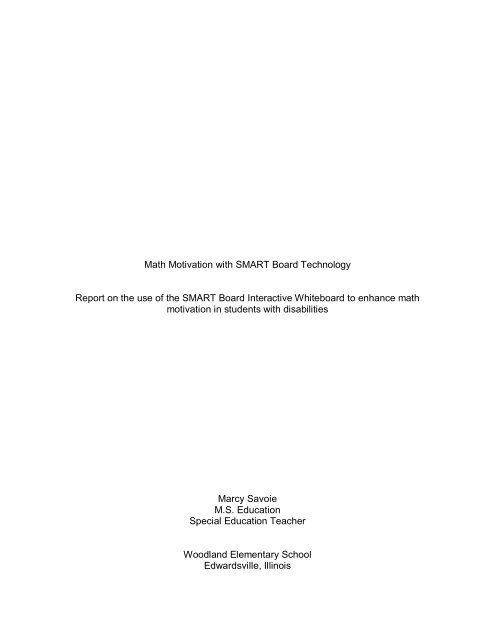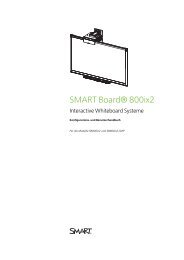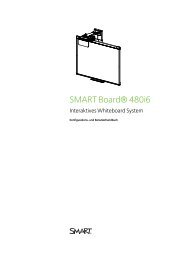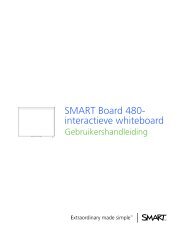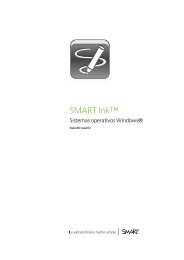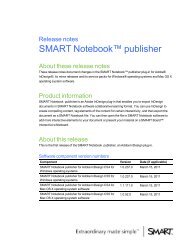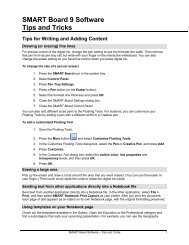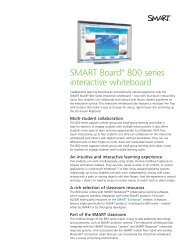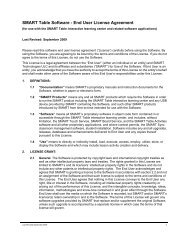Math Motivation with SMART Board Technology
Math Motivation with SMART Board Technology
Math Motivation with SMART Board Technology
Create successful ePaper yourself
Turn your PDF publications into a flip-book with our unique Google optimized e-Paper software.
<strong>Math</strong> <strong>Motivation</strong> <strong>with</strong> <strong>SMART</strong> <strong>Board</strong> <strong>Technology</strong><br />
Report on the use of the <strong>SMART</strong> <strong>Board</strong> Interactive Whiteboard to enhance math<br />
motivation in students <strong>with</strong> disabilities<br />
Marcy Savoie<br />
M.S. Education<br />
Special Education Teacher<br />
Woodland Elementary School<br />
Edwardsville, Illinois
Purpose<br />
My project’s objective is to increase students’ motivation in math through<br />
the use of technology, specifically through the use of the <strong>SMART</strong> <strong>Board</strong>.<br />
Students <strong>with</strong> learning disabilities, often due to past frustration, sometimes have<br />
a lack of motivation toward learning. They also may learn in different ways from<br />
their non-disabled peers. <strong>Technology</strong> such as the <strong>SMART</strong> <strong>Board</strong> helps students<br />
<strong>with</strong> different learning styles learn more effectively (Bell, 2002). This in turn<br />
increases motivation. Visual learners can see their work projected and gain<br />
immediate feedback on their work. Auditory learners can use different software<br />
to interact <strong>with</strong> the board. Tactile learners can use different colored pens to write<br />
on the board and highlight important ideas. The <strong>SMART</strong> <strong>Board</strong> is an exciting and<br />
important tool in increasing motivation in the classroom.<br />
Background<br />
Pedagogically, my study is significant in that it will demonstrate how<br />
technology can motivate students <strong>with</strong> learning disabilities to reach their full<br />
potential. In order to improve motivation to learn, it is important to present<br />
lessons and assign learning activities that are fun and interesting. This in turn will<br />
increase motivation in students. (Bos, Schumm & Vaughn, 2003).The <strong>SMART</strong><br />
<strong>Board</strong> helps to present lessons in a fun, interesting and creative way. BECTA<br />
(British Educational Communications and <strong>Technology</strong> Agency, 2003) describes<br />
how increased motivation is a key benefit from Interactive Whiteboards. Also, the
ability to present and talk about students’ work helps to raise self-esteem and<br />
keep students on task. As Jones (2004) states in his research, current studies<br />
demonstrate that Interactive Whiteboards engage pupils more than traditional<br />
teaching and increase motivation and enjoyment. William D. Beeland, Jr.,<br />
(Beeland, 2002) completed a research study on student engagement and<br />
Interactive Whiteboards. His research clearly indicated that Interactive<br />
Whiteboards increase student engagement during the learning process.<br />
Dev, P.C.,(2006) conducted a study on intrinsic motivation relating to<br />
students <strong>with</strong> learning disabilities. He noted three psychological needs that<br />
motivate an individual intrinsically. They are a desire to feel self-determining,<br />
competent and connected to others. The Interactive Whiteboard allows students<br />
<strong>with</strong> learning disabilities to meet all three needs.<br />
Research Design<br />
The students in this study consisted of seven students in the fifth grade.<br />
These students are in a self-contained cross-categorical special education class.<br />
Disabilities in this class include autism, bi-polar disorder, behavioral disorder,<br />
attention deficit disorder, cognitive delay, learning disability, and cerebral palsy.<br />
These students all struggle <strong>with</strong> learning basic math facts and math concepts as<br />
well as a lack of motivation toward learning math.<br />
My research strategy is to collect data over 3 periods: pre-<strong>SMART</strong> <strong>Board</strong><br />
period, introductory <strong>SMART</strong> <strong>Board</strong> period and a concluding <strong>SMART</strong> <strong>Board</strong><br />
period. This strategy will allow me to test my hypothesis that use of the <strong>SMART</strong>
<strong>Board</strong> increases motivation in math for students <strong>with</strong> special needs. The time<br />
frame is as follows:<br />
Pre-<strong>SMART</strong> <strong>Board</strong> period: August 21, 2007 to October 24, 2007 45 days<br />
Introductory <strong>SMART</strong> <strong>Board</strong> period: October 25, 2007 to January 14, 2008 45 days<br />
Concluding <strong>SMART</strong> <strong>Board</strong> period: January 15, 2008 to March 31, 2008 45 days<br />
I will show that the <strong>SMART</strong> <strong>Board</strong> increases motivation by giving a 10<br />
question survey of how the students feel about learning math facts and concepts.<br />
The first survey will be given pre-<strong>SMART</strong> <strong>Board</strong>; the second survey will be given<br />
during the training period; and the last survey will be given when the students are<br />
familiar and comfortable using the <strong>SMART</strong> <strong>Board</strong> on a daily basis. One study<br />
that supports this finding is by Miller, Glover & Averis (2005). Using the<br />
Interactive White <strong>Board</strong> to teach math encouraged intrinsic stimulation, sustained<br />
focus and stepped learning. For example, using ‘virtual manipulatives,’ such as a<br />
fraction wall, will allow students to better visualize and master the target concept.<br />
Penny Latham (2004) describes in her study how children were asked to<br />
find the area of shapes. The students, <strong>with</strong> the help of the Interactive White<br />
<strong>Board</strong>, were able to imagine, describe, and model solutions to the problem. The<br />
research in support of using the Interactive White <strong>Board</strong> to effectively teach math<br />
and motivate students is very persuasive. My students who have learning<br />
disabilities would be able to access their specific learning needs and styles<br />
thanks to the <strong>SMART</strong> <strong>Board</strong>.
Sample Student Survey<br />
Name _______________________________ Date __________________ <strong>Math</strong><br />
Survey<br />
Rate the following statements using the given scale.<br />
1= agree<br />
2= not sure<br />
3 = disagree<br />
1. <strong>Math</strong> class is interesting.<br />
2. I understand what I am learning in math class.<br />
3. <strong>Math</strong> class is hard for me.<br />
4. I try my best in math class.<br />
Statement Rating<br />
5. I can’t understand what I am learning in math class.<br />
6. I can understand what the teacher is teaching me on the board.<br />
7. I like to tell my family what I am learning in math class.<br />
8. <strong>Math</strong> class is boring.<br />
9. I like math class.<br />
10. I look forward to math class.
The results from the survey are as follows:<br />
Question #1 <strong>Math</strong> class is interesting.<br />
7<br />
6<br />
5<br />
4<br />
3<br />
2<br />
1<br />
0<br />
Pre-<strong>SMART</strong><br />
<strong>Board</strong><br />
Introductory<br />
<strong>SMART</strong> <strong>Board</strong><br />
Concluding<br />
<strong>SMART</strong> <strong>Board</strong><br />
Question #2 I understand what I am learning in math class.<br />
7<br />
6<br />
5<br />
4<br />
3<br />
2<br />
1<br />
0<br />
Pre-<strong>SMART</strong><br />
<strong>Board</strong><br />
Introductory<br />
<strong>SMART</strong> <strong>Board</strong><br />
Question #3 <strong>Math</strong> class is hard for me.<br />
7<br />
6<br />
5<br />
4<br />
3<br />
2<br />
1<br />
0<br />
Pre-<strong>SMART</strong><br />
<strong>Board</strong><br />
Introductory<br />
<strong>SMART</strong> <strong>Board</strong><br />
Concluding<br />
<strong>SMART</strong> <strong>Board</strong><br />
Concluding<br />
<strong>SMART</strong> <strong>Board</strong><br />
1=agree<br />
2=not sure<br />
3=disagree<br />
1=agree<br />
2=not sure<br />
3=disagree<br />
1=agree<br />
2=not sure<br />
3=disagree
Question #4 I try my best in math class.<br />
7<br />
6<br />
5<br />
4<br />
3<br />
2<br />
1<br />
0<br />
Pre-<strong>SMART</strong><br />
<strong>Board</strong><br />
Introductory<br />
<strong>SMART</strong> <strong>Board</strong><br />
Concluding<br />
<strong>SMART</strong> <strong>Board</strong><br />
Question #5 I can’t understand what I am learning in math class.<br />
7<br />
6<br />
5<br />
4<br />
3<br />
2<br />
1<br />
0<br />
Pre-<strong>SMART</strong><br />
<strong>Board</strong><br />
Introductory<br />
<strong>SMART</strong> <strong>Board</strong><br />
Concluding<br />
<strong>SMART</strong> <strong>Board</strong><br />
1=agree<br />
2=not sure<br />
3=disagree<br />
1=agree<br />
2=not sure<br />
3=disagree<br />
Question #6 I can understand what the teacher is teaching me on the board.<br />
7<br />
6<br />
5<br />
4<br />
3<br />
2<br />
1<br />
0<br />
Pre-<strong>SMART</strong><br />
<strong>Board</strong><br />
Introductory<br />
<strong>SMART</strong> <strong>Board</strong><br />
Concluding<br />
<strong>SMART</strong> <strong>Board</strong><br />
1=agree<br />
2=not sure<br />
3=disagree
Question #7 I like to tell my family what I am learning in math class.<br />
7<br />
6<br />
5<br />
4<br />
3<br />
2<br />
1<br />
0<br />
Pre-<strong>SMART</strong><br />
<strong>Board</strong><br />
Introductory<br />
<strong>SMART</strong> <strong>Board</strong><br />
Question #8 <strong>Math</strong> class is boring.<br />
7<br />
6<br />
5<br />
4<br />
3<br />
2<br />
1<br />
0<br />
Pre-<strong>SMART</strong><br />
<strong>Board</strong><br />
Introductory<br />
<strong>SMART</strong> <strong>Board</strong><br />
Question #9 I like math class.<br />
7<br />
6<br />
5<br />
4<br />
3<br />
2<br />
1<br />
0<br />
Pre-<strong>SMART</strong><br />
<strong>Board</strong><br />
Introductory<br />
<strong>SMART</strong> <strong>Board</strong><br />
Concluding<br />
<strong>SMART</strong> <strong>Board</strong><br />
Concluding<br />
<strong>SMART</strong> <strong>Board</strong><br />
Concluding<br />
<strong>SMART</strong> <strong>Board</strong><br />
1=agree<br />
2=not sure<br />
3=disagree<br />
1=agree<br />
2=not sure<br />
3=disagree<br />
1=agree<br />
2=not sure<br />
3=disagree
Question #10 I look forward to math class.<br />
7<br />
6<br />
5<br />
4<br />
3<br />
2<br />
1<br />
0<br />
Pre-<strong>SMART</strong><br />
<strong>Board</strong><br />
Introductory<br />
<strong>SMART</strong> <strong>Board</strong><br />
Concluding<br />
<strong>SMART</strong> <strong>Board</strong><br />
1=agree<br />
2=not sure<br />
3=disagree
Results and Evaluation<br />
The hypotheses stated that the use of the <strong>SMART</strong> <strong>Board</strong> would increase<br />
motivation in math for students <strong>with</strong> special needs. Evidence to support this<br />
hypothesis was found in evaluating the survey results from the Pre-<strong>SMART</strong><br />
<strong>Board</strong> period, Introductory <strong>SMART</strong> <strong>Board</strong> period, and the Concluding <strong>SMART</strong><br />
<strong>Board</strong> Period. Students noted that math class was more interesting and more<br />
understandable <strong>with</strong> the use of the <strong>SMART</strong> <strong>Board</strong>. They also were more likely to<br />
share what they are learning <strong>with</strong> their families. Students who had previously not<br />
liked math class, noted that they now liked math class. Students also looked<br />
forward to math class after the introduction of the <strong>SMART</strong> <strong>Board</strong>. Some<br />
observations noted by the teacher were that students were more engaged during<br />
the learning process. Concepts that were difficult to understand became clearer<br />
<strong>with</strong> the help of 3-D imagery and virtual math manipulatives. In conclusion, the<br />
<strong>SMART</strong> <strong>Board</strong> is a valuable tool to help students <strong>with</strong> special needs reach their<br />
full potential in math. The hypothesis was correct in that motivation was<br />
increased in math after the introduction of the <strong>SMART</strong> <strong>Board</strong>. After teaching <strong>with</strong><br />
the <strong>SMART</strong> <strong>Board</strong>, I have observed how much my students have learned this<br />
year. I am thankful for the <strong>SMART</strong>er Kids Foundation for giving me this<br />
opportunity to have the <strong>SMART</strong> <strong>Board</strong> become a part of my classroom.
References<br />
BECTA Research Reviews (2003) What the Research Says about Interactive Whiteboards.<br />
Paper No. 7 Retrieved June 8, 2007 from the World Wide Web:<br />
http://www.becta.org.uk/page_documents/research/wtrs_whiteboards.pdf<br />
Bell. M..2002. Why use an Interactive Whiteboard? A baker’s dozen reasons! Teachers.<br />
Net Gazette, 3(1) January 2002. Retrieved August 13, 2006 from the World Wide Web:<br />
http://teachers.net/gazette/Jan02/mabell.html<br />
Bos, C.S., Schumm,J.S., & Vaughn, S. (2003) Teaching Exceptional, Diverse, and At-Risk<br />
Students in the General Education Classroom. Boston: Allyn and Bacon.<br />
Brown, A., Miller, D., & Robinson, I. (2002, Nov/Dec.). Widgets on the Web. Teaching Exceptional<br />
Children, 35(2).<br />
Dev,P.C., (1996). Intrinsic <strong>Motivation</strong> and the Students <strong>with</strong> Learning disabilities. (ED 403723).<br />
Retrieved on April 23, 2007 from the World Wide Web:<br />
http://digitalcommons.libraries.columbia.edu/dissertations/AAI3005801/<br />
Edwards, J., Hartnell, M., & Martin, R. (2002) Interactive Whiteboards, Some Lessons for the<br />
Classroom. Micromath, 18 (2) 30-34.<br />
Jones, K. (2004), Using Interactive Whiteboards in the Teaching and Learning of <strong>Math</strong>ematiics: a<br />
Research Bibliography, Micromath, 20 (2), 5-6.<br />
Latham, Penny. Teaching and Learning Primary <strong>Math</strong>ematics: The Impact of Interactive<br />
Whiteboards. (2002) Retrieved June 9, 2007 from the World Wide Web:<br />
http://www.bsrlm.org.uk/IPs/ip25-1/BSRLM-IP-25-1-14.pdf<br />
Miller, D., Glover, D., & Averis, D. (2005), Presentation and Pedagogy: the Effective Use of<br />
Interactive Whiteboards in <strong>Math</strong>ematics Lessons, in D. Hewiitt and A. Noyes (Eds),<br />
Proceedings of the Sixth British Congress of <strong>Math</strong>ematics Education held at the<br />
University of Warwick, pp. 105-112. Retrieved from the World Wide Web on May 23,<br />
2007: http://www.bsrlm.org.uk/IPs/ip25-1/BSRLM-IP-25-1-14.pdf


